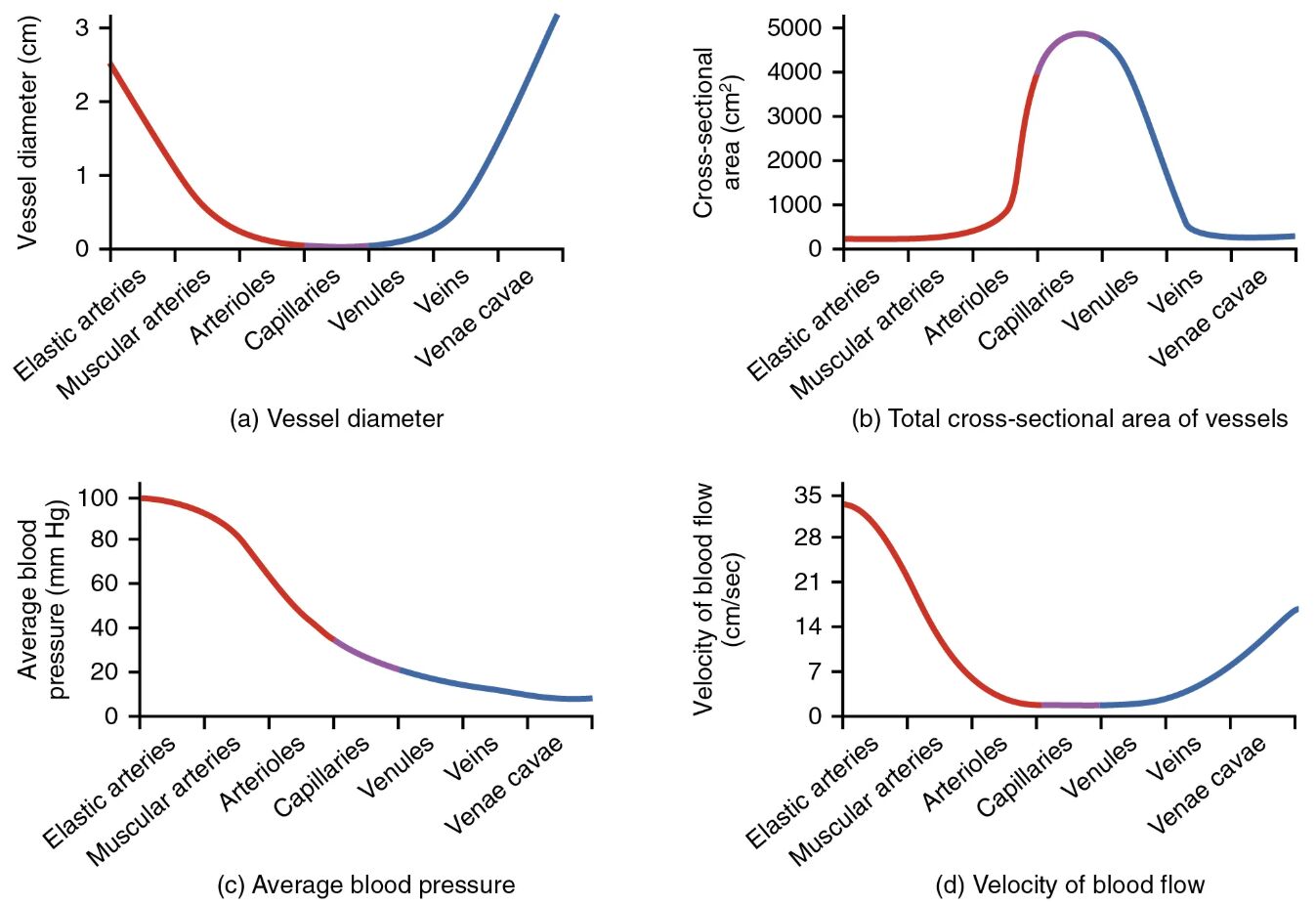The systemic circuit’s blood vessels play a critical role in maintaining circulation, distributing oxygen and nutrients throughout the body. This diagram explores the interconnections among vessel diameter, total cross-sectional area, average blood pressure, and velocity of blood flow, offering a comprehensive view of cardiovascular dynamics.

Vessel diameter Vessel diameter refers to the internal width of blood vessels, decreasing from large elastic arteries to tiny capillaries. This variation influences blood flow resistance, with larger diameters in arteries like the aorta facilitating high-pressure flow and smaller diameters in capillaries enhancing exchange.
Total cross-sectional area of vessels Total cross-sectional area of vessels represents the cumulative area available for blood flow across all vessels of a given type. It increases dramatically in capillaries due to their vast numbers, peaking at around 4,500-5,000 cm², which slows blood velocity for efficient exchange.
Average blood pressure Average blood pressure is the mean pressure exerted by blood on vessel walls, highest in elastic arteries at around 100 mmHg. It drops significantly through capillaries and veins, reaching near 0 mmHg in venae cavae, reflecting the pressure gradient driving circulation.
Velocity of blood flow Velocity of blood flow measures the speed of blood movement, highest in elastic arteries at approximately 35 cm/sec. It decreases in capillaries to about 0.3 cm/sec due to the increased cross-sectional area, then rises again in veins as the total area narrows.
Elastic arteries Elastic arteries, such as the aorta, have a large diameter and high pressure, supporting the initial propulsion of blood. Their elastic walls absorb pulsatile flow, ensuring a steady distribution to downstream vessels.
Muscular arteries Muscular arteries, like the brachial artery, have a moderate diameter and maintain pressure around 80-100 mmHg. They regulate blood flow to specific organs through muscular walls that can constrict or dilate.
Arterioles Arterioles, the smallest arteries, have a reduced diameter and pressure around 40-60 mmHg. They control blood entry into capillaries, acting as key regulators of peripheral resistance.
Capillaries Capillaries possess the smallest diameter, optimizing exchange with tissues at a low pressure of 20-40 mmHg. Their vast number increases the total cross-sectional area, slowing flow for efficient nutrient and gas transfer.
Venules Venules collect blood from capillaries with a slightly larger diameter and pressure around 10-20 mmHg. They transition blood from the microcirculation to the venous system, aiding return flow.
Veins Veins have a larger diameter than arterioles, with pressure dropping to 5-10 mmHg. Their thin walls and valves assist in returning deoxygenated blood to the heart against gravity.
Venae cavae Venae cavae, the largest veins, have the widest diameter and near-zero pressure. They serve as the final conduit delivering blood to the right atrium, supported by thoracic pressure changes.
Overview of Vascular Relationships
This diagram illustrates how vessel characteristics interact to sustain circulation. Each parameter reflects the body’s adaptation to meet metabolic demands efficiently.
- Vessel diameter decreases from arteries to capillaries, then increases in veins, affecting flow resistance.
- Total cross-sectional area of vessels peaks in capillaries, facilitating exchange, then decreases in veins.
- Average blood pressure declines progressively, driven by friction and vessel branching.
- Velocity of blood flow adjusts inversely to cross-sectional area, ensuring adequate perfusion.
- These relationships maintain a balance between pressure, flow, and exchange across the systemic circuit.
Vessel Diameter and Its Impact
The variation in vessel diameter shapes blood flow dynamics across the circuit. This structural difference supports the system’s functional diversity.
- Elastic arteries have a diameter of about 2-3 cm, handling high-pressure surges from the heart.
- Muscular arteries range from 0.5-1 cm, distributing blood with controlled resistance.
- Arterioles narrow to 0.01-0.1 cm, fine-tuning flow to capillaries.
- Capillaries are tiny at 0.007-0.01 cm, maximizing surface area for exchange.
- Veins and venae cavae widen again, up to 0.5-3 cm, to accommodate low-pressure return.
Total Cross-Sectional Area Dynamics
The total cross-sectional area of vessels influences flow velocity and exchange efficiency. This parameter highlights the capillary bed’s critical role.
- Elastic arteries contribute a small area, around 5 cm², due to their few numbers.
- Muscular arteries and arterioles increase slightly to 20-50 cm², reflecting branching.
- Capillaries dominate with 4,500-5,000 cm², enabling extensive exchange.
- Venules and veins reduce to 200-500 cm², consolidating flow.
- Venae cavae narrow to about 10 cm², preparing for atrial entry.
Blood Pressure and Flow Velocity
Average blood pressure and velocity of blood flow are inversely related, governed by Poiseuille’s law. This interplay ensures adequate tissue perfusion.
- Elastic arteries maintain 100 mmHg with a velocity of 35 cm/sec, driven by cardiac output.
- Muscular arteries drop to 80-100 mmHg, with velocity around 28-35 cm/sec.
- Arterioles reduce pressure to 40-60 mmHg, slowing velocity to 14-21 cm/sec.
- Capillaries reach 20-40 mmHg with 0.3 cm/sec, optimizing exchange time.
- Veins and venae cavae fall to 0-10 mmHg, with velocity rising to 7-14 cm/sec due to reduced area.
Clinical Relevance of Vascular Relationships
Understanding these parameters aids in diagnosing circulatory issues. Variations can indicate underlying pathologies or guide treatment.
- High average blood pressure in elastic arteries may suggest hypertension, straining vessel walls.
- Low velocity of blood flow in capillaries can impair oxygen delivery in conditions like diabetes.
- Increased total cross-sectional area of vessels in veins supports venous return, critical in heart failure.
- Monitoring vessel diameter changes helps assess atherosclerosis progression.
- These insights enhance therapeutic strategies, from vasodilators to surgical interventions.
In conclusion, the relationships among vessels in the systemic circuit reveal a finely tuned system balancing vessel diameter, total cross-sectional area of vessels, average blood pressure, and velocity of blood flow. This understanding deepens appreciation for how the body maintains circulation, offering a foundation for both routine health checks and advanced medical care.

